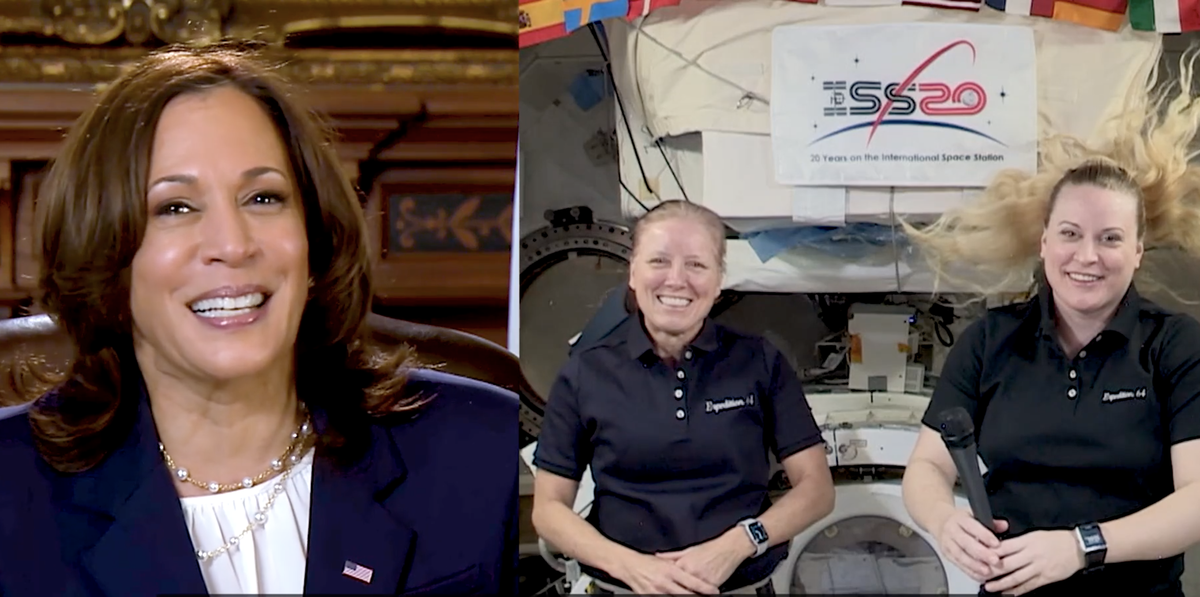In Today’s Deep Space Extra… Vice President Harris spoke to the female astronauts currently living aboard the International Space Station in celebration of Women’s History Month. New image of black hole reveals surrounding magnetic fields.
Human Space Exploration
Watch VP Harris speak to NASA astronauts in space
Marie Claire (3/24): Vice President Kamala Harris placed a special call to NASA astronauts Kate Rubins and Shannon Walker, who are currently aboard the International Space Station (ISS), in celebration of Women’s History Month. The astronauts spoke about some of the work that is going on aboard the ISS, such as testing free-floating satellites that will help with future exploration of the Moon and Mars and studying worms to look at how muscle strength changes in space.
NASA’s next-gen Orion spacecraft makes a splash in latest test
Digital Trends (3/24): Engineers at NASA began a series of four water impact drop tests for NASA’s next-generation Orion spacecraft to better understand what the spacecraft and its crew may experience when landing in the ocean after missions to the Moon, starting with Artemis II, the first crewed mission in NASA’s program to return to the lunar surface. The water-impact tests are similar to those carried out several years ago, but the crew module has since been upgraded with structural improvements.
Space Science
The European Space Agency is developing on autonomous robot to explore the Moon’s caves
The Next Web (3/24): Daedalus, a spherical robotic sphere developed by the European Space Agency (ESA), is designed to descend into lunar caves, or lava tubes, with a tether that will enable the robot to explore and report back what it discovers, perhaps water ice. Measures of radiation could reveal whether the caves are habitable. The goal is to find resources and locations that could take humans closer to settling on the Moon.
First image of a black hole gets a polarizing update that sheds light on magnetic fields
Space.com (3/24): A new look at the massive black hole at the center of the M 87 galaxy reveals its appearance in polarized light, illustrating the intense magnetic field and the radio jets shooting out. Two studies of the polarized light were published in the Astrophysical Journal Letters.
Opinion
NASA’s Space Launch System is America’s ride to the Moon and beyond
The Hill (3/24): In an op-ed, retired NASA astronaut Tom Jones, a veteran of four space shuttle missions, offers praise to NASA and its Space Launch System (SLS) contractor team for their persistence in working through the hot fire phase of the Green Run ground test sequence on March 18. The full duration test fire of the large rocket’s four engines has prepared the SLS to launch humans back to the surface of the Moon and beyond. “I can tell you that human spaceflight is a hard, complex endeavor,” writes Jones “And when astronauts’ lives are at stake, you must get it right the first time.”
Other News
Cosmic mouthful: Tasters savor fine wine that orbited Earth
Associated Press (3/24): Researchers in Bordeaux, France, are analyzing a dozen bottles of wine and 320 snippets of grapevines that returned to Earth this year after traveling to the International Space Station (ISS). The researchers said weightlessness didn’t ruin the wine, and it seemed to have energized the vines. The study is part of an effort to make plants on Earth more resilient to climate change and disease by exposing them to new stresses, and to better understand the aging process and fermentation of wine.
World’s oldest meteor crater isn’t what is seems
Space.com (3/25): Scientists now believe that what was thought to be the world’s oldest meteor impact, or the “crater” that is known as the Maniitsoq structure, located in Greenland, was actually created by natural forces. The new study calls into question the findings from 2012 which stated there was evidence that the Maniitsoq structure was created by a meteor impact, calling it the earliest known example of its kind on Earth.

